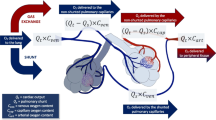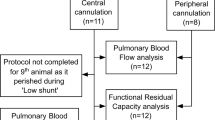Abstract
The pulmonary shunt fraction (\({{\dot Qs} \mathord{\left/ {\vphantom {{\dot Qs} {\dot Qt}}} \right. \kern-\nulldelimiterspace} {\dot Qt}}\)) is frequently calculated in critically ill patients to monitor the effectiveness of pulmonary oxygenation. The breathing of pure oxygen often results in higher calculated\({{\dot Qs} \mathord{\left/ {\vphantom {{\dot Qs} {\dot Qt}}} \right. \kern-\nulldelimiterspace} {\dot Qt}}\) values that have been attributed to the development of atelectasis, ventilation-perfusion imbalance, or both. To interpret properly the changes in calculated\({{\dot Qs} \mathord{\left/ {\vphantom {{\dot Qs} {\dot Qt}}} \right. \kern-\nulldelimiterspace} {\dot Qt}}\) that occur when the inspired oxygen fraction is altered, the changes produced in all the variables affecting\({{\dot Qs} \mathord{\left/ {\vphantom {{\dot Qs} {\dot Qt}}} \right. \kern-\nulldelimiterspace} {\dot Qt}}\) must be known. This tutorial presents an in-depth analysis of the four variables affecting the calculation of\({{\dot Qs} \mathord{\left/ {\vphantom {{\dot Qs} {\dot Qt}}} \right. \kern-\nulldelimiterspace} {\dot Qt}}\) \(\dot Vo_2 \) (oxygen uptake),\(\dot Qt\) (cardiac output), Cc'O2(oxygen content in pulmonary end capillaries), and\(C\bar vO_2 \) (oxygen content in mixed venous blood). These variables are related according to the following equation, which derived by combining the Fick and the classic shunt equations:\({{\dot Qs} \mathord{\left/ {\vphantom {{\dot Qs} {\dot Qt}}} \right. \kern-\nulldelimiterspace} {\dot Qt}} = 1 - [({{{{\dot Vo_2 } \mathord{\left/ {\vphantom {{\dot Vo_2 } {\dot Qt}}} \right. \kern-\nulldelimiterspace} {\dot Qt}})} \mathord{\left/ {\vphantom {{{{\dot Vo_2 } \mathord{\left/ {\vphantom {{\dot Vo_2 } {\dot Qt}}} \right. \kern-\nulldelimiterspace} {\dot Qt}})} {(Cc'O_2 }}} \right. \kern-\nulldelimiterspace} {(Cc'O_2 }} - C\bar vO_2 )]\). Three-dimensional surface representations relating these variables are also presented to help the reader understand the effects of these variables on the calculated\({{\dot Qs} \mathord{\left/ {\vphantom {{\dot Qs} {\dot Qt}}} \right. \kern-\nulldelimiterspace} {\dot Qt}}\).
Similar content being viewed by others
References
Bartels H, Dejours P, Kellogg RH, Mead J. Glossary on respiration and gas exchange. J Appl Physiol 1973;34:549–558
Comroe JH Jr, Forster RE II, Dubois AB, et al. The lung, 2nd ed. Chicago: Year Book, 1962;343–345
Douglas ME, Downs JB, Dannemiller FJ, et al. Change in pulmonary venous admixture with varying inspired oxygen. Anesth Analg 1976;55:688–695
McAslan TC, Matjasko-Chiu J, Turney SZ, Cowley RA. Influence of inhalation of 100% oxygen on intrapulmonary shunt in severely traumatized patients. J Trauma 1973;13:811–821
Kerr JH. Pulmonary oxygen transfer during IPPV in man. Br J Anaesth 1975;47:695–705
Suter PM, Fairley HB, Schlobohm RM. Shunt, lung volume and perfusion during short periods of ventilation with oxygen. Anesthesiology 1975;43:617–627
Quan SF, Kronberg GM, Schlobohm RM, et al. Changes in venous admixture with alterations of inspired oxygen concentration. Anesthesiology 1980;52:477–482
Oliven A, Abinader E, Bursztein S. Influence of varying inspired oxygen tensions on the pulmonary venous admixture (shunt) of mechanically ventilated patients. Crit Care Med 1980;8:99–101
Gallagher TJ, Civetta JM. Goal-directed therapy of acute respiratory failure. Anesth Analg 1980;59:831–834
Rahn H, Fenn W. A graphical analysis of the respiratory gas exchange. The O2-CO2 diagram. Washington, DC: American Physiological Society, 1955:1–41
Farhi LE. Recent advances in respiratory physiology. Ventilation-perfusion relationship and its role in alveolar gas exchange. London: WH Arnold, 1965:148–197
Philbin DM, Sullivan SF, Bowman FO, et al. Postoperative hypoxemia: contribution of cardiac output. Anesthesiology 1970;32:136–142
Berggren SM. The oxygen deficit of arterial blood caused by non-ventilating parts of the lung. Acta Physiol Scand 1942; 4:Suppl 11:1–92
Johnson SF, Cruz JC, McDonald JS. Spatial representation of the Fick and shunt models. Fed Proc 1982;41:1129
Cruz JC, Reilley TE. A new approach to analyze the shunt in the critically ill patient. Crit Care Med 1982;10:236
Cruz JC, Reilley TE. Mechanisms of changes in venous admixture by augmenting inspired oxygen concentration. Fed Proc 1982;41:1129
Kelman GR, Nunn JF, Prys-Roberts C, Greenbaum R. The influence of cardiac output on arterial oxygenation: a theoretical study. Br J Anaesth 1967;39:450–457
Smith G, Cheney FW Jr, Winter PM. The effect of change in cardiac output on intrapulmonary shunting. Br J Anaesth 1974;46:337–342
Bishop MJ, Cheney FW. Effects of pulmonary blood flow and mixed venous O2 tension on gas exchange in dogs. Anesthesiology 1983;58:130–135
Cruz JC. The open book, model for the oxygen uptake, cardiac output and shunt fraction relationships. Proc Int Union Physiol Sci 1986;16:176
Cruz JC, Beaver BL, Reilley TE, McDonald JS. Changes in oxygen uptake, cardiac output and/or mixed venous O2 difference produced by augmenting inspired O2. Anesthesiology 1982;57:A122
Schaefer KE. Circulatory adaptation to the requirements of life under more than one atmosphere of pressure. In: Hamilton WF, Dow P, eds. Handbook of physiology. Vol 3. Washington, DC: American Physiological Society, 1965:1843–1873
West JB. Regional differences in gas exchange in the lung of erect man. J Appl Physiol 1962;17:893–898
Author information
Authors and Affiliations
Rights and permissions
About this article
Cite this article
Cruz, J.C., Metting, P.J. Understanding the meaning of the shunt fraction calculation. J Clin Monitor Comput 3, 124–134 (1987). https://doi.org/10.1007/BF00858361
Received:
Revised:
Accepted:
Issue Date:
DOI: https://doi.org/10.1007/BF00858361




